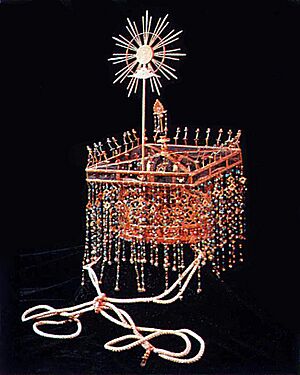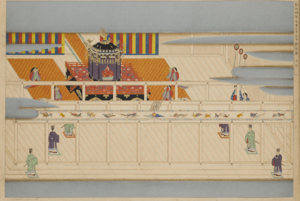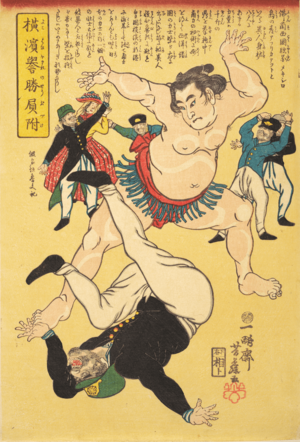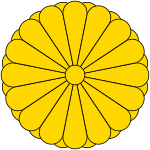Emperor Kōmei facts for kids
Quick facts for kids Emperor Kōmei孝明天皇 |
|||||
|---|---|---|---|---|---|
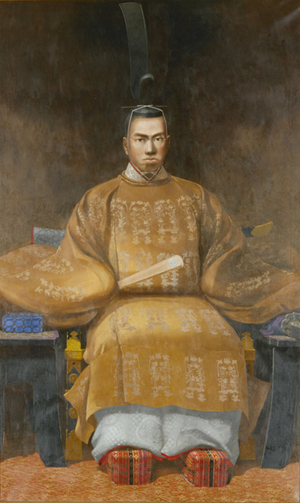
Portrait by Koyama Shōtarō, 1902
|
|||||
| Emperor of Japan | |||||
| Reign | 10 March 1846 – 30 January 1867 | ||||
| Enthronement | 31 October 1847 | ||||
| Predecessor | Ninkō | ||||
| Successor | Meiji | ||||
| Shōguns |
See list
|
||||
| Born | Osahito (統仁) 22 July 1831 Kyoto, Japan |
||||
| Died | 30 January 1867 (aged 35) Kyoto Imperial Palace, Kyoto, Japan |
||||
| Burial | Nochi no tsuki no wa no misasagi (後月輪東山陵), Kyoto | ||||
| Spouse | Asako Kujō | ||||
| Issue | |||||
|
|||||
| House | Imperial House of Japan | ||||
| Father | Emperor Ninkō | ||||
| Mother | Fujiwara no Tsuneko | ||||
| Religion | Shinto | ||||
| Signature |  |
||||
Emperor Kōmei (孝明天皇, Kōmei-tennō, 22 July 1831 – 30 January 1867) was the 121st Emperor of Japan. He ruled from 1846 to 1867. This was during the very end of the Edo period in Japan.
During his time as emperor, Japan faced big changes. It had its first major contact with the United States. This happened when Commodore Perry arrived in 1853 and 1854. Japan was then forced to open up to Western countries. Before this, Japan had been closed off from the world for 220 years. Emperor Kōmei did not like foreign things. He was against opening Japan to Western powers. His rule was filled with disagreements and conflicts. These events led to the end of the Tokugawa shogunate. This happened shortly after his death. Then came the Meiji Restoration, which was a big change for Japan. It started at the beginning of his son's rule, Emperor Meiji.
Contents
Early Life of Emperor Kōmei
Before he became emperor, his personal name was Osahito (統仁). His title was Hiro-no-miya (煕宮). Osahito was born on July 22, 1831. He was the fourth son of Emperor Ninkō. His mother was Ōgimachi Naoko. Osahito and his family lived in the Dairi of the Heian Palace.
Emperor Kōmei's Reign
Prince Osahito became Emperor on March 10, 1846. This happened after his father passed away. During Kōmei's reign, Japan was led by the Tokugawa shogunate. Its leaders were Tokugawa Ieyoshi, Tokugawa Iesada, Tokugawa Iemochi, and Tokugawa Yoshinobu.
On July 8, 1853, US Commodore Matthew Perry arrived. He came with his "Black Ships" to make Japan trade. The Tokugawa shogunate had ruled Japan for about 300 years. But they found it hard to deal with this new challenge. At this time, Emperor Kōmei only had symbolic power in Kyoto.
The shogunate was having internal problems. It slowly gave up power to foreign countries. This happened because of threats of military force. Emperor Kōmei then started to gain more power. He got back some of the powers his ancestors had given up. The Emperor's younger sister, Imperial princess Kazu-no-Miya Chikako (和宮親子内親王), married the Tokugawa shōgun Tokugawa Iemochi. This was part of a plan to unite the Imperial Court and the Shogunate. Both the Emperor and his sister were against this marriage. But the Emperor knew it could help him connect with Japan's true ruler. Emperor Kōmei did not like foreign things. He was against opening Japan to Western powers. This was true even as the shogun kept agreeing to foreign demands.
Talking with the Shogunate
On January 22, 1858, a group from the shogunate asked Emperor Kōmei for advice. They wanted to know how to deal with the new foreign powers. This was the first time the Emperor's advice was actively sought. It showed a shift in power. Many messengers started traveling between Edo (now Tokyo) and Kyoto.
In October 1858, Hayashi Akira went to Kyoto. He was sent to explain the terms of the Treaty of Amity and Commerce (日米修好通商条約). This treaty was also called the Harris Treaty. Hayashi had to explain the terms to the Emperor. He also needed to get the Emperor's approval. Kōmei finally agreed in February 1859. He understood there was no other choice.
In 1863, Shogun Tokugawa Iemochi visited Kyoto. This was a very important moment. It showed a change in how the military shogunate and the Imperial Court related. It also played a role in what became the Meiji Restoration. The Emperor receiving the shogun in the Kyoto palace showed a new political order. This was further shown when Emperor Kōmei visited the Kamo shrine, with the shogun following him. This public event proved that a new order was taking shape.
After accepting the Harris Treaty, Japan signed similar treaties. These were called the Ansei Treaties. They were signed with Russia, France, Great Britain, and the Netherlands. These treaties said that foreigners could live and trade in certain Japanese cities. These cities included Edo, Nagasaki, Niigata, Kobe and Yokohama. The treaties also said that foreign residents would follow their own country's laws. This was called extraterritoriality. They would not follow the Japanese legal system.
The "Order to Expel Barbarians"
Emperor Kōmei was very unhappy with most things happening during his rule. He never met any foreigners and did not know much about them. Unequal trade treaties were signed without his approval. He even offered to resign twice to protest.
During his reign, he started to gain more power. This happened as the Tokugawa shogunate weakened. Emperor Kōmei agreed with feelings against Westerners. He started to take a more active role in state matters. This was unusual for an emperor at that time. He spoke out against the treaties. He also tried to influence who would be the next shogun.
His efforts led to his "Order to expel barbarians" in 1863. The Shogunate did not plan to enforce this order. But it still inspired attacks against the Shogunate and foreigners. One famous event was the killing of a British trader. This showed that Japan could not match the military power of Western countries. Military fights were not a good solution for diplomacy.
Illness and Death
In January 1867, the Emperor became sick with smallpox. This was surprising because he had not been ill before. On January 30, 1867, he died after a severe illness. He had purple spots on his face.
Some people at the time rumored that he was assassinated. They thought it might have been by radical groups. However, there is no proof of this. Most people believe he died from smallpox. This was a common disease around the world at that time.
By the time Emperor Kōmei died, the government was in trouble. Japan was also surrounded by powerful countries. These countries wanted to gain influence through trade. Kōmei's son, Imperial Prince Mutsuhito, became Emperor Meiji in 1868. These big problems were addressed during the Meiji Restoration.
After Kōmei's death in 1867, he was buried in the Imperial mausoleum. It is called Nochi no Tsukinowa no Higashi no misasagi (後月輪東山陵). It is located at Sennyū-ji in Higashiyama-ku, Kyoto. Many other emperors are also buried there.
Emperor Kōmei was the last emperor to get a posthumous name after his death. From his son, Emperor Meiji, onwards, the posthumous name was chosen in advance. It was the same as their reign name.
Important Court Officials
Kugyō (公卿) was a term for the most powerful men in the Emperor's court. This was before the Meiji period. Even when the court had little power outside the palace, this group was still important.
This group usually had only three to four men at a time. They were courtiers from important families. They had a lot of experience and reached the highest positions in their careers.
Eras During Kōmei's Reign
Emperor Kōmei was the last Japanese Emperor to have more than one era name (nengō) during his rule. Starting with his son, Emperor Meiji, each emperor had only one era name. This name did not change until the emperor died.
There were seven nengō during Kōmei's reign:
- Kōka (1844–1848)
- Kaei (1848–1854)
- Ansei (1854–1860)
- Man'en (1860–1861)
- Bunkyū (1861–1864)
- Genji (1864–1865)
- Keiō (1865–1868)
Family of Emperor Kōmei
Emperor Kōmei had six children. Four were daughters and two were sons. But only his son, the future Emperor Meiji, lived to be an adult. Kōmei's main wife was Asako Kujō (九条夙子). After Kōmei died in 1867, Asako was given the title Empress Dowager Eishō (英照皇太后) by Emperor Meiji.
His son, Imperial Prince Mutsuhito, later became Emperor Meiji. His mother was Nakayama Yoshiko (中山慶子).
See also
 In Spanish: Kōmei Tennō para niños
In Spanish: Kōmei Tennō para niños
- Emperor of Japan
- List of Emperors of Japan
- Imperial cult
- Heian Shrine
- Tsuki no wa no misasagi
|
Emperor Kōmei
Born: 22 July 1831 Died: 30 January 1867 |
||
| Regnal titles | ||
|---|---|---|
| Preceded by Emperor Ninkō |
Emperor of Japan 10 March 1846 – 30 January 1867 |
Succeeded by Emperor Meiji |


